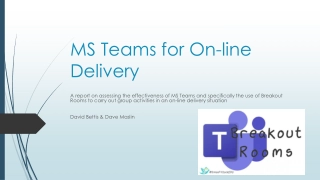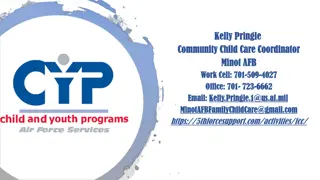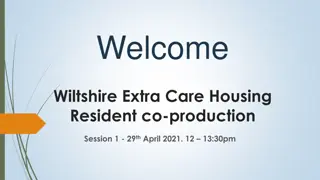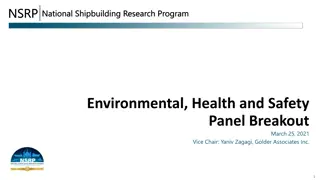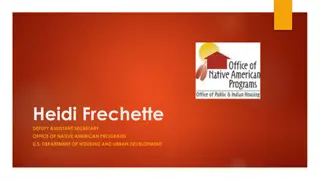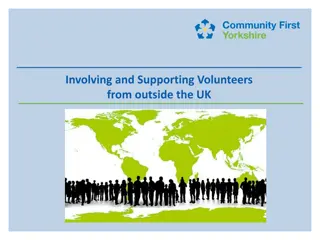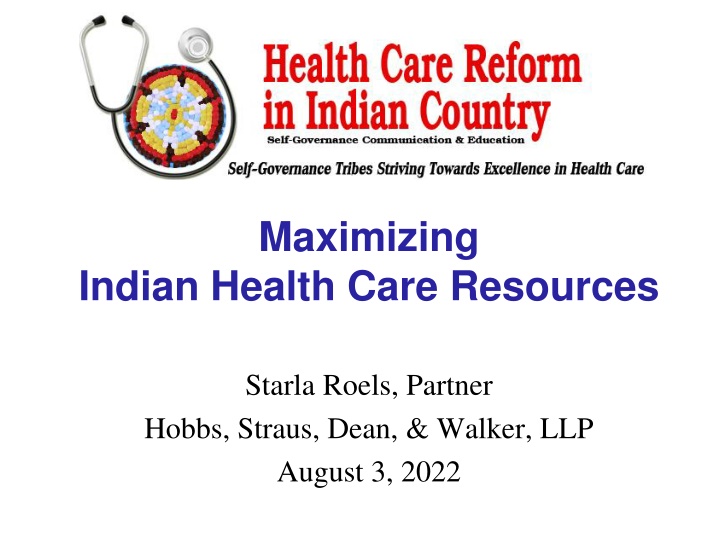
Maximize Indian Health Care Resources for Medicare, Medicaid, and Third-Party Reimbursements
Discover how to optimize Indian Health Service funding through third-party reimbursements, Medicare-like rates, and Medicaid provisions. Learn strategies to expand funding sources and enhance cost savings for health programs.
Download Presentation

Please find below an Image/Link to download the presentation.
The content on the website is provided AS IS for your information and personal use only. It may not be sold, licensed, or shared on other websites without obtaining consent from the author. If you encounter any issues during the download, it is possible that the publisher has removed the file from their server.
You are allowed to download the files provided on this website for personal or commercial use, subject to the condition that they are used lawfully. All files are the property of their respective owners.
The content on the website is provided AS IS for your information and personal use only. It may not be sold, licensed, or shared on other websites without obtaining consent from the author.
E N D
Presentation Transcript
Maximizing Indian Health Care Resources Starla Roels, Partner Hobbs, Straus, Dean, & Walker, LLP August 3, 2022
Primary Goals Receive a general overview of Medicare, Medicaid and other third-party resources Gain an understanding of your ability to maximize third-party resources and achieve cost savings for your program Learn about Section 105(l) leases
Funding Health Programs Third-Party Reimbursements * Medicare * Medicaid * Veterans Affairs Premium Sponsorship Medicare Like Rates Services to Non-Beneficiaries IHS Funding, including CSC and 105(l) leases * CHIP * Private Insurance
This Training Session IHS Funding Third-Party Revenues Insurance and Premium Sponsorship Medicare Like Rates Non-Beneficiaries
IHS Funding IHS Budget increases Assume additional PSFAs retained by IHS Update CSC indirect cost rate Proper accounting of expenditure of IHS funds can result in increased CSC Section 105(l) leases (discuss at the end)
IHS Funding Expand Scope of Work Not only important for FTCA Can add PSFAs even if IHS does not pay (e.g., long-term care) Use other sources of funding like M/M to pay for them, leverage other billing options
Third-Party Revenues Enrolling patients in available third-party sources to pay for their care saves IHS resources Payor of Last Resort rules Use of third-party revenues for health care-related reasons as program income to carry out ISDEAA scope
Medicaid Medicaid provides health coverage for lower income and disabled Americans The ACA allows States to expand Medicaid coverage to everyone up to 138 % of the Federal Poverty Line: $18,754 for an individual $38,295 for a family of four $51,322 for a family of six, etc.
Medicaid| Tribal Provisions AI/AN are exempt from premiums and cost- sharing in Medicaid Trust resources exempt from the calculation of income for purposes of determining Medicaid eligibility CMS reimburses States 100 percent of the cost of Medicaid services received through IHS/tribal facilities (100% FMAP)
Medicaid| Tribal Provisions Many tribal facilities are eligible to receive the IHS OMB rate for services provided to Indians IHS is the payor of last resort, so Medicaid pays first Special managed care protections for IHS/Tribal providers and Indians enrolled in Medicaid managed care plans
Medicaid| Benefits Every State s Medicaid plan is different and covers different optional services Every Medicaid plan has special provisions for IHS and tribal providers. Some are better than others The best plans generally allow IHS/tribal providers to bill for up to 5 encounters a day per patient at the IHS OMB encounter rates
Medicaid| Benefits The best plans allow IHS/tribal providers to bill telehealth and tele-behavioral health visits at the same IHS OMB rates Some plans have Tribal specific provisions that relax limitations on visits, etc. that apply elsewhere Some states allow cost savings from care coordination agreements with outside providers to be used for Tribal health programs
Medicare Medicare provides services to persons over 65 and disabled population Part A Hospital Insurance Part B Medical Insurance Part C Medicare Advantage Plans Part D Prescription Drugs
Medicare| Tribal Sponsorship Part B Plans Tribes have the authority to sponsor (pay for) Medicare Part B premiums for their eligible patients. The Affordable Care Act authorizes tribes to use federal funds to do so Tribes can then bill Medicare Part B for the cost of providing services to their members, which is more than the cost of the premiums Tribes must make each sponsorship payment separately
Medicare| Tribal Sponsorship Part D Plans Tribes have the authority to sponsor (pay for) Medicare Part D premiums for their eligible patients Tribes can then bill Medicare Part D for the cost of pharmaceuticals, which is more than the cost of the premiums Tribes can enter into contracts with Part D providers to reimburse them for services. The Part D providers are required to use an Indian-specific contract addendum that protects tribal rights
VA| Tribal Reimbursement Agreements The IHS and the VA have entered into a national MOU and a reimbursement agreement Section 405(c) of the IHCIA requires VA to pay for health care for AI/AN veterans, primary to IHS and T/TOs, for all services provided through the IHS or T/TO health programs Many T/TOs have entered into sharing/reimbursement agreements with the VA for direct care services PRC for Native Veterans Act (Jan. 2021) clarified that VA must also reimburse for PRC (and not just during the COVID- 19 emergency)
Access to Federal Insurance The Affordable Care Act authorized Tribes to purchase the same lower cost insurance coverage for their employees as the federal government Tribes now have access to the Federal Employee Health Benefit program The program offers nationwide and local plans which may provide better coverage at lower cost to the Tribe
Insurance | Premium Sponsorship The ACA authorized tribes to use federal sources of funding (e.g., PRC funding) to buy insurance coverage for their members in their service area Tribes can use this authority to buy coverage for their members on the private market, or through the ACA marketplace The idea is to leverage the existing federal funds to purchase coverage the Tribe can bill when providing services There are a number of Indian-specific cost sharing protections in the Marketplace rules that can make premium sponsorship Marketplace coverage a good idea for tribes
Insurance| Marketplace Rules AI/AN have no cost sharing in the marketplace--do not have to pay co-pays or deductibles As a result, they can enroll in a plan with low premiums and high cost sharing (i.e. a bronze plan) and pay no cost sharing Individuals with incomes between 100-400 % of the federal poverty level (and over 400% for 2022), qualify for premium reductions called premium assistance For 2022, 400 % of the federal poverty level for a family of four is $111,000 (higher in AK)
Medicare Like Rates Two types: Hospital and Non-Hospital MLR for hospital services applies automatically, and requires all hospital providers (inpatient, outpatient, etc.) to accept payment at Medicare-like rates for authorized PRC claims MLR for non-hospital and physician services must be implemented by adopting them through a Funding Agreement. Non-hospital MLR is not binding on providers MLR can result in significant cost savings for PRC plans. PRC can be integrated into Self-Insured Plan to get the benefit of MLR for tribal members covered by tribal self- insurance.
Services to Non-Beneficiaries Section 813(c) of the IHCIA authorizes T/TOs to determine to serve non-eligible individuals if no denial or diminution of services to eligible beneficiaries Must be on a fee-for-service basis (usually through third-party coverage like private insurance or Medicaid) Opportunities for innovative partnerships with Non- IHS Providers
Section 105(l) Leases Section 105(l) of the ISDEAA requires the IHS and BIA to enter a lease with a T/TO for any facility owned or leased by the program used to carry out the ISDEAA scope of work. Lease must fully compensate T/TO for reasonable, non-duplicative costs of operating and maintaining the facility. Options: Fair market rental Costs incurred, like rent, depreciation, O&M, repairs, other Combination of both
Section 105(l) Leases Tribes across the country are taking advantage of this opportunity. Set process with IHS. Leases must be fully funded, though IHS can decline unreasonable or duplicative costs. Congress has now guaranteed full funding of all Section 105(l) leases, providing such sums as may be necessary in an indefinite discretionary appropriation
Questions or Comments? Starla Roels sroels@hobbsstraus.com 503-242-1745




